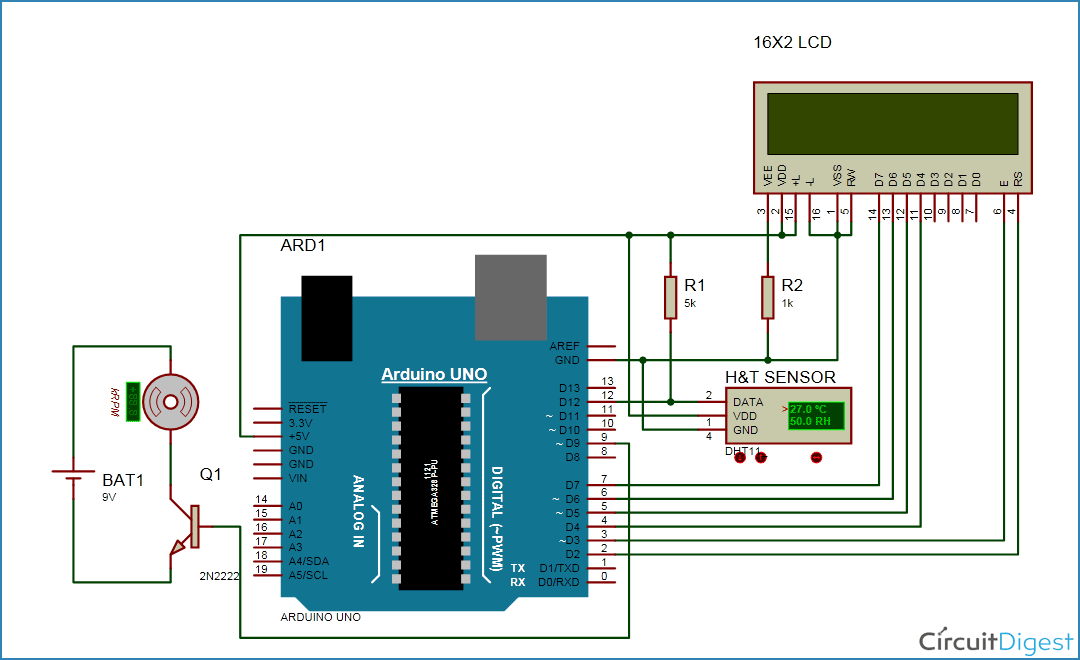
Automatic Temperature Controlled Fan Using Arduino
In this arduino based project, we are going to control DC fan speed according to the room temperature and show these parameter changes on a 16x2 LCD display. It is accomplished by the data communications between Arduino, LCD, DHT11 sensor Module and DC fan that is controlled by using PWM. PWM is a technique by using which we can control voltage. Circuit Components • Arduino UNO • DHT11 sensor • DC Fan • 2n2222 transistor • 9 volt battery • 16x2 LCD • 1K resistor • Connecting wires This project consists of three sections.
One senses the temp erature by using humidity and temperature sensor namely DHT11. Second section reads the dht11 sensor module’s output and extracts temperature value into a suitable number in Celsiu s scale and control the fan speed by using PWM.
And last part of system shows humidity and temperature on LCD and Fan driver. Here in this project we have used a sensor module namely DHT11 that are already have discuss our previous project namely “”. Here we have only used this DHT sensor for sensing temperature, and then programmed our arduino according to the requirements. Working of this project is very simple. We have created PWM at pwm pin of arduino and applied it at base terminal of transistor. Then transistor creates a voltage according to the pwm input.
Automatic Temperature Controlled Fan: This is a project on a automatic fan which changes it's speed with change in temperature. The temperature of the room is displayed on the lcd.It is a cheap, fun and easy project to do. Using an analog temperature LM35 interfaced to the built in ADC of a programmed Arduino to develop varying duty cycle of PWM output for a driver IC to run a.
Fan speed and PWM values and duty cycles values are showing in given table Temperature Duty Cycle PWM Value Fan Speed Less 26 0% 0 Off 26 20% 51 20% 27 40% 102 40% 28 60% 153 60% 29 80% 204 80% Greater 29 100% 255 100% What is PWM? PWM is a technique by using we can control the voltage or power. To understand it more simply, if you are applying 5 volt for driving a motor then motor will moving with some speed, now if we reduces applied voltage by 2 means we apply 3 volt to motor then motor speed also decreases. This concept is used in the project to control the voltage using PWM. (To understand more about PWM, check this circuit: ) The main game of PWM is digital pulse with some duty cycle and this duty cycle is responsible for controlling the speed or voltage. Suppose we have a pule with duty cycle 50% that means it will give half of voltage that we apply.
- It has two separate powerful Bass and Treble adjustment. - It has a10 band optimized graphical equalizer for all supported formats, presets, custom presets. - It comes with stereo eXpansion, mono mixing, balance. Musixmatch plugin for poweramp download. - It has unique features which can crossfade, gapless, replay gain.
Formula for duty cycle given below: Duty Cycle= Ton/T Where T= total time or Ton+Toff And Ton= On time of pulse (means 1 ) And Toff= Off time of pulse (means 0) Circuit Description Connections of this temperature controlled fan circuit is very simple, here a liquid crystal display is used for displaying temperature and Fan speed Status. LCD is directly connected to arduino in 4-bit mode (Check this tutorial for more details: ). Pins of LCD namely RS, EN, D4, D5, D6 and D7 are connected to arduino digital pin number 7, 6, 5, 4, 3 and 2. And a DHT11 sensor module is also connected to digital pin 12 of arduino. Digital pin 9 is used for controlling fan speed trough transistor.

Code Description First we include the library for lcd and dht sensor and then define pin for lcd, dht sensor and for fan. Then initialize all the things in setup loop. And in loop by using dht function reads DHT sensor and then using some dht functions we extract temperature and display these on LCD. After this we compare the temperature with pre define temperature digit and then generate PWM according to the temperature value. For generating PWM we have used “analogWrite(pin, PWM value)” fuction in 8 bit. Mean if PWM value is equivalent of analog value. So if we need to generate 20% of duty cycle then we passes 255/5 value as PWM in “analogWrite” Function.